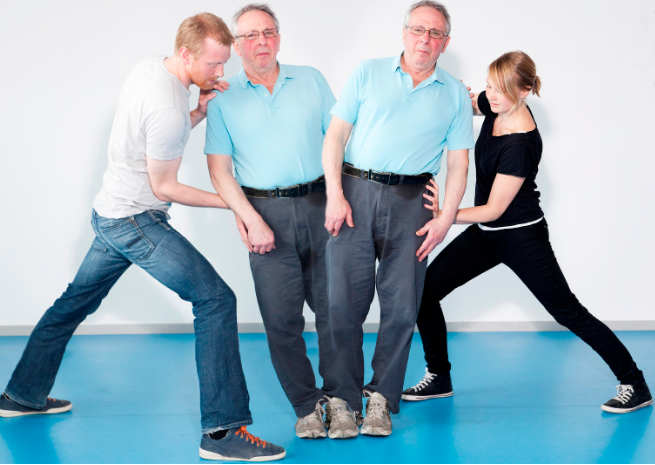Mini-BESTest (Balance Evaluation Systems Test)
- Fysiobasen

- Sep 18
- 4 min read
The Mini-BESTest is a shortened and specialized tool developed to evaluate dynamic balance. Derived from the original BESTest, it focuses on identifying six different systems of balance control. This enables clinicians to design targeted rehabilitation programs for patients with balance impairments. The test has demonstrated high clinical utility and is validated across several populations, including individuals with stroke, Parkinson’s disease, and vestibular disorders.

Summary
The Mini-BESTest is a time-efficient, validated tool for evaluating dynamic balance across diverse patient groups. It consists of 14 tasks assessing anticipatory adjustments, reactive postural control, sensory orientation, and dynamic gait. The test demonstrates excellent reliability, predictive validity, and is widely used to identify fall risk, guide rehabilitation, and measure treatment outcomes.
Advantages and Limitations
Advantages
Focus on dynamic balance: Evaluates four of six key balance domains – anticipatory control, reactive postural control, sensory orientation, and dynamic gait.
Time-efficient: Takes only 10–15 minutes and requires minimal equipment.
High reliability and validity: Test–retest reliability (ICC = 0.96) and inter-rater reliability (ICC = 0.98) across populations.
Adaptable: Suitable for neurological conditions such as stroke, Parkinson’s disease, and vestibular disorders.
Limitations
Scoring variations: Differences in total score calculation (28 vs. 32 points) may cause confusion.
Limited use in severe cases: Less suitable for patients with very impaired physical function.
Ceiling effect: May be less sensitive for small improvements in patients with mild balance problems.
Structure and Scoring System
The Mini-BESTest consists of 14 tasks evaluating different aspects of balance. Each item is scored on a 3-point ordinal scale:
0 = Severe impairment
1 = Moderate impairment
2 = Normal performance
Maximum score = 28. Some studies use an extended 32-point scale when both right and left sides are assessed.
Administration of the Mini-BESTest
The 14 tasks are grouped into four domains: anticipatory adjustments, reactive postural control, sensory orientation, and dynamic gait.
Sit to stand
Instruction: Cross arms over chest and stand up without using hands.
Scoring: (2) No hands, (1) Uses hands once, (0) Needs assistance.
Rise to toes
Instruction: Rise up as high as possible on toes and hold for 3 seconds.
Scoring: (2) Stable for 3 sec, (1) Limited height/unstable, (0) Unable.
Stand on one leg
Instruction: Stand on one leg, lift the other backward, look forward.
Scoring: (2) 20 sec, (1) <20 sec, (0) Unable.
4–6. Compensatory stepping (forward, backward, sideways)
Instruction: Lean until support is released, step to prevent falling.
Scoring: (2) One large step, (1) Multiple steps, (0) No step/fall.
7–9. Static positions
Feet together, eyes open (firm surface).
Feet together, eyes closed (foam).
Eyes closed on incline.
Scoring: (2) 30 sec, (1) <30 sec, (0) Unable.
Change in gait speed
Instruction: Walk at normal, then fast, then slow pace.
Scoring: (2) No balance loss, (1) Reduced control, (0) Unable.
Gait with horizontal head turns
Instruction: Walk while turning head left and right.
Scoring: (2) Straight path, (1) Slower pace, (0) Loses balance.
Pivot turn
Instruction: Turn 180° while walking.
Scoring: (2) <3 steps, (1) >4 steps, (0) Loses balance.
Step over obstacle
Instruction: Step over a box without changing speed.
Scoring: (2) Clears easily, (1) Touches/slows down, (0) Unable.
Timed Up and Go (TUG) with dual task
Instruction: Perform TUG while counting backwards by 3s.
Scoring: (2) No change, (1) Change in one task, (0) Stops walking/counting.
Reliability and Validity
Reliability
Test–retest reliability: ICC = 0.96 (excellent).
Inter-rater reliability: ICC = 0.98 (excellent).
Internal consistency: Cronbach’s α = 0.90–0.91.
Validity
Criterion validity: Strong correlation with Berg Balance Scale (r = 0.85) and Timed Up and Go (r = –0.82).
Fall prediction: Cut-off ≤17.5 points identifies fall risk (sensitivity/specificity = 64%).
Construct validity: Differentiates fallers vs. non-fallers, and levels of Parkinson’s severity.
Content validity: Tasks derived from established measures (BBS, DGI, TUG).
Sensitivity and specificity
Minimal clinically important difference (MCID): 4 points.
Responsiveness: AUC = 0.92 for detecting meaningful improvement after rehabilitation.
Clinical Utility
The Mini-BESTest is widely used to:
Evaluate fall risk: Cut-off ≤17.5 points.
Guide rehabilitation: Provides targeted areas for intervention.
Measure treatment outcomes: Sensitive to balance changes over time.
Sources:
1. Franchignoni, F., Horak, F., Godi, M., Nardone, A., & Giordano, A. (2010). Using psychometric techniques to improve the Balance Evaluation System’s Test: The Mini-BESTest. Journal of Rehabilitation Medicine, 42(4), 323-331. https://doi.org/10.2340/16501977-0537
2. Godi, M., Franchignoni, F., et al. (2013). Comparison of reliability, validity, and responsiveness of the Mini-BESTest and Berg Balance Scale in patients with balance disorders. Physical Therapy, 93(2), 158-167. https://doi.org/10.2522/ptj.20120214
3. King, L. A., & Horak, F. B. (2013). Letters and Responses: On the Mini-BESTest: Scoring and the Reporting of Total Scores. Physical Therapy, 93(5), 571-575. https://doi.org/10.2522/ptj.20130206
4. Tsang, C. S., Liao, L. R., Chung, R. C., & Pang, M. Y. (2013). Psychometric properties of the Mini-Balance Evaluation Systems Test (Mini-BESTest) in community-dwelling individuals with chronic stroke. Physical Therapy, 93(8), 1102-1115. https://doi.org/10.2522/ptj.20120481
5. Leddy, A. L., Crowner, B. E., & Earhart, G. M. (2011). Utility of the Mini-BESTest, BESTest, and BESTest sections for balance assessments in individuals with Parkinson disease. Journal of Neurologic Physical Therapy, 35(2), 90-97. https://doi.org/10.1097/NPT.0b013e3182130816
6. Duncan, R. P., Leddy, A. L., & Earhart, G. M. (2013). Comparative utility of the BESTest, Mini-BESTest, and Brief-BESTest for predicting falls in individuals with Parkinson disease: A cohort study. Physical Therapy, 93(4), 542-550. https://doi.org/10.2522/ptj.20120302
7. Bergstrom, M., Lenholm, E., et al. (2012). Translation and validation of the Swedish version of the Mini-BESTest in subjects with Parkinson's disease or stroke: A pilot study. Physiotherapy Theory and Practice, 28(7), 509-514. https://doi.org/10.3109/09593985.2011.644752









